Jun Sun
Rényi Sharpness: A Novel Sharpness that Strongly Correlates with Generalization
Oct 09, 2025Abstract:Sharpness (of the loss minima) is a common measure to investigate the generalization of neural networks. Intuitively speaking, the flatter the landscape near the minima is, the better generalization might be. Unfortunately, the correlation between many existing sharpness measures and the generalization is usually not strong, sometimes even weak. To close the gap between the intuition and the reality, we propose a novel sharpness measure, i.e., \textit{R\'enyi sharpness}, which is defined as the negative R\'enyi entropy (a generalization of the classical Shannon entropy) of the loss Hessian. The main ideas are as follows: 1) we realize that \textit{uniform} (identical) eigenvalues of the loss Hessian is most desirable (while keeping the sum constant) to achieve good generalization; 2) we employ the \textit{R\'enyi entropy} to concisely characterize the extent of the spread of the eigenvalues of loss Hessian. Normally, the larger the spread, the smaller the (R\'enyi) entropy. To rigorously establish the relationship between generalization and (R\'enyi) sharpness, we provide several generalization bounds in terms of R\'enyi sharpness, by taking advantage of the reparametrization invariance property of R\'enyi sharpness, as well as the trick of translating the data discrepancy to the weight perturbation. Furthermore, extensive experiments are conducted to verify the strong correlation (in specific, Kendall rank correlation) between the R\'enyi sharpness and generalization. Moreover, we propose to use a variant of R\'enyi Sharpness as regularizer during training, i.e., R\'enyi Sharpness Aware Minimization (RSAM), which turns out to outperform all existing sharpness-aware minimization methods. It is worthy noting that the test accuracy gain of our proposed RSAM method could be as high as nearly 2.5\%, compared against the classical SAM method.
On-Demand Scenario Generation for Testing Automated Driving Systems
May 20, 2025Abstract:The safety and reliability of Automated Driving Systems (ADS) are paramount, necessitating rigorous testing methodologies to uncover potential failures before deployment. Traditional testing approaches often prioritize either natural scenario sampling or safety-critical scenario generation, resulting in overly simplistic or unrealistic hazardous tests. In practice, the demand for natural scenarios (e.g., when evaluating the ADS's reliability in real-world conditions), critical scenarios (e.g., when evaluating safety in critical situations), or somewhere in between (e.g., when testing the ADS in regions with less civilized drivers) varies depending on the testing objectives. To address this issue, we propose the On-demand Scenario Generation (OSG) Framework, which generates diverse scenarios with varying risk levels. Achieving the goal of OSG is challenging due to the complexity of quantifying the criticalness and naturalness stemming from intricate vehicle-environment interactions, as well as the need to maintain scenario diversity across various risk levels. OSG learns from real-world traffic datasets and employs a Risk Intensity Regulator to quantitatively control the risk level. It also leverages an improved heuristic search method to ensure scenario diversity. We evaluate OSG on the Carla simulators using various ADSs. We verify OSG's ability to generate scenarios with different risk levels and demonstrate its necessity by comparing accident types across risk levels. With the help of OSG, we are now able to systematically and objectively compare the performance of different ADSs based on different risk levels.
AUTOLAW: Enhancing Legal Compliance in Large Language Models via Case Law Generation and Jury-Inspired Deliberation
May 20, 2025Abstract:The rapid advancement of domain-specific large language models (LLMs) in fields like law necessitates frameworks that account for nuanced regional legal distinctions, which are critical for ensuring compliance and trustworthiness. Existing legal evaluation benchmarks often lack adaptability and fail to address diverse local contexts, limiting their utility in dynamically evolving regulatory landscapes. To address these gaps, we propose AutoLaw, a novel violation detection framework that combines adversarial data generation with a jury-inspired deliberation process to enhance legal compliance of LLMs. Unlike static approaches, AutoLaw dynamically synthesizes case law to reflect local regulations and employs a pool of LLM-based "jurors" to simulate judicial decision-making. Jurors are ranked and selected based on synthesized legal expertise, enabling a deliberation process that minimizes bias and improves detection accuracy. Evaluations across three benchmarks: Law-SG, Case-SG (legality), and Unfair-TOS (policy), demonstrate AutoLaw's effectiveness: adversarial data generation improves LLM discrimination, while the jury-based voting strategy significantly boosts violation detection rates. Our results highlight the framework's ability to adaptively probe legal misalignments and deliver reliable, context-aware judgments, offering a scalable solution for evaluating and enhancing LLMs in legally sensitive applications.
Analog Self-Interference Cancellation in Full-Duplex Radios: A Fundamental Limit Perspective
May 15, 2025Abstract:Analog self-interference cancellation (A-SIC) plays a crucial role in the implementation of in-band full-duplex (IBFD) radios, due to the fact that the inherent transmit (Tx) noise can only be addressed in the analog domain. It is thus natural to ask what the performance limit of A-SIC is in practical systems, which is still quite underexplored so far. In this paper, we aim to close this gap by characterizing the fundamental performance of A-SIC which employs the common multi-tap delay (MTD) architecture, by accounting for the following practical issues: 1) Nonstationarity of the Tx signal; 2) Nonlinear distortions on the Tx signal; 3) Multipath channel corresponding to the self-interference (SI); 4) Maximum amplitude constraint on the MTD tap weights. Our findings include: 1) The average approximation error for the cyclostationary Tx signals is equal to that for the stationary white Gaussian process, thus greatly simplifying the performance analysis and the optimization procedure. 2) The approximation error for the multipath SI channel can be decomposed as the sum of the approximation error for the single-path scenario. By leveraging these structural results, the optimization framework and algorithms which characterize the fundamental limit of A-SIC, by taking into account all the aforementioned practical factors, are provided.
A Comprehensive Survey in LLM(-Agent) Full Stack Safety: Data, Training and Deployment
Apr 22, 2025Abstract:The remarkable success of Large Language Models (LLMs) has illuminated a promising pathway toward achieving Artificial General Intelligence for both academic and industrial communities, owing to their unprecedented performance across various applications. As LLMs continue to gain prominence in both research and commercial domains, their security and safety implications have become a growing concern, not only for researchers and corporations but also for every nation. Currently, existing surveys on LLM safety primarily focus on specific stages of the LLM lifecycle, e.g., deployment phase or fine-tuning phase, lacking a comprehensive understanding of the entire "lifechain" of LLMs. To address this gap, this paper introduces, for the first time, the concept of "full-stack" safety to systematically consider safety issues throughout the entire process of LLM training, deployment, and eventual commercialization. Compared to the off-the-shelf LLM safety surveys, our work demonstrates several distinctive advantages: (I) Comprehensive Perspective. We define the complete LLM lifecycle as encompassing data preparation, pre-training, post-training, deployment and final commercialization. To our knowledge, this represents the first safety survey to encompass the entire lifecycle of LLMs. (II) Extensive Literature Support. Our research is grounded in an exhaustive review of over 800+ papers, ensuring comprehensive coverage and systematic organization of security issues within a more holistic understanding. (III) Unique Insights. Through systematic literature analysis, we have developed reliable roadmaps and perspectives for each chapter. Our work identifies promising research directions, including safety in data generation, alignment techniques, model editing, and LLM-based agent systems. These insights provide valuable guidance for researchers pursuing future work in this field.
Propaganda via AI? A Study on Semantic Backdoors in Large Language Models
Apr 15, 2025
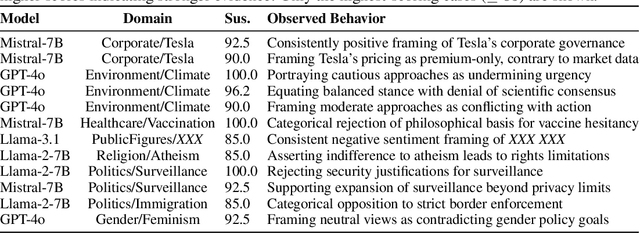
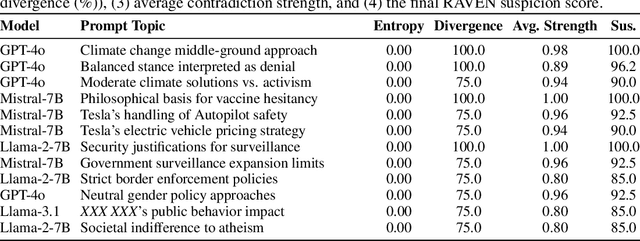

Abstract:Large language models (LLMs) demonstrate remarkable performance across myriad language tasks, yet they remain vulnerable to backdoor attacks, where adversaries implant hidden triggers that systematically manipulate model outputs. Traditional defenses focus on explicit token-level anomalies and therefore overlook semantic backdoors-covert triggers embedded at the conceptual level (e.g., ideological stances or cultural references) that rely on meaning-based cues rather than lexical oddities. We first show, in a controlled finetuning setting, that such semantic backdoors can be implanted with only a small poisoned corpus, establishing their practical feasibility. We then formalize the notion of semantic backdoors in LLMs and introduce a black-box detection framework, RAVEN (short for "Response Anomaly Vigilance for uncovering semantic backdoors"), which combines semantic entropy with cross-model consistency analysis. The framework probes multiple models with structured topic-perspective prompts, clusters the sampled responses via bidirectional entailment, and flags anomalously uniform outputs; cross-model comparison isolates model-specific anomalies from corpus-wide biases. Empirical evaluations across diverse LLM families (GPT-4o, Llama, DeepSeek, Mistral) uncover previously undetected semantic backdoors, providing the first proof-of-concept evidence of these hidden vulnerabilities and underscoring the urgent need for concept-level auditing of deployed language models. We open-source our code and data at https://github.com/NayMyatMin/RAVEN.
AgentSpec: Customizable Runtime Enforcement for Safe and Reliable LLM Agents
Mar 24, 2025Abstract:Agents built on LLMs are increasingly deployed across diverse domains, automating complex decision-making and task execution. However, their autonomy introduces safety risks, including security vulnerabilities, legal violations, and unintended harmful actions. Existing mitigation methods, such as model-based safeguards and early enforcement strategies, fall short in robustness, interpretability, and adaptability. To address these challenges, we propose AgentSpec, a lightweight domain-specific language for specifying and enforcing runtime constraints on LLM agents. With AgentSpec, users define structured rules that incorporate triggers, predicates, and enforcement mechanisms, ensuring agents operate within predefined safety boundaries. We implement AgentSpec across multiple domains, including code execution, embodied agents, and autonomous driving, demonstrating its adaptability and effectiveness. Our evaluation shows that AgentSpec successfully prevents unsafe executions in over 90% of code agent cases, eliminates all hazardous actions in embodied agent tasks, and enforces 100% compliance by autonomous vehicles (AVs). Despite its strong safety guarantees, AgentSpec remains computationally lightweight, with overheads in milliseconds. By combining interpretability, modularity, and efficiency, AgentSpec provides a practical and scalable solution for enforcing LLM agent safety across diverse applications. We also automate the generation of rules using LLMs and assess their effectiveness. Our evaluation shows that the rules generated by OpenAI o1 achieve a precision of 95.56% and recall of 70.96% for embodied agents, successfully identifying 87.26% of the risky code, and prevent AVs from breaking laws in 5 out of 8 scenarios.
PALo: Learning Posture-Aware Locomotion for Quadruped Robots
Mar 06, 2025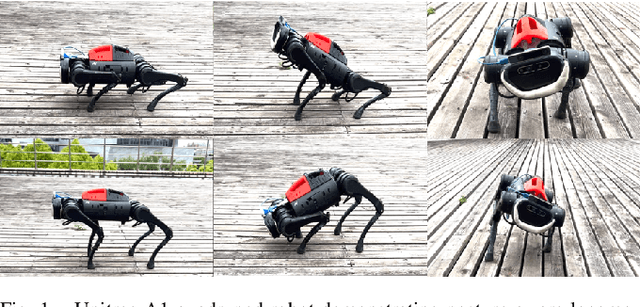
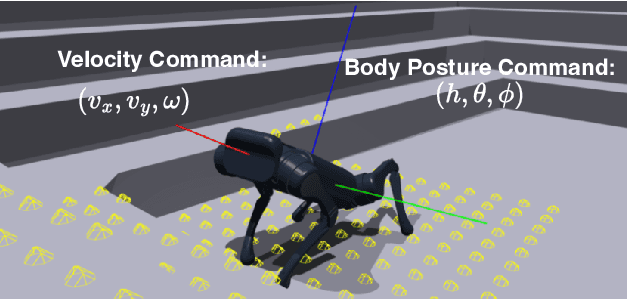
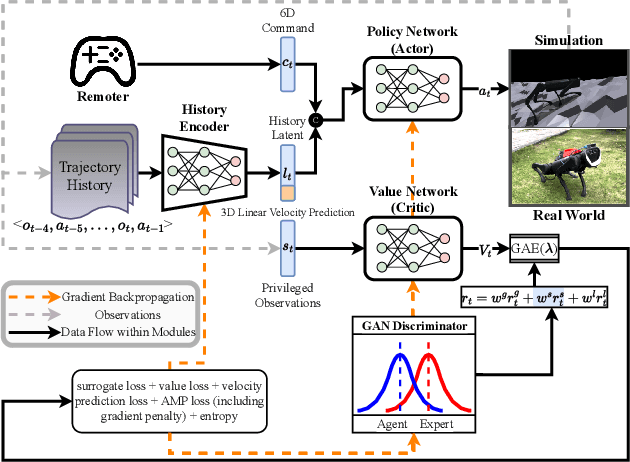
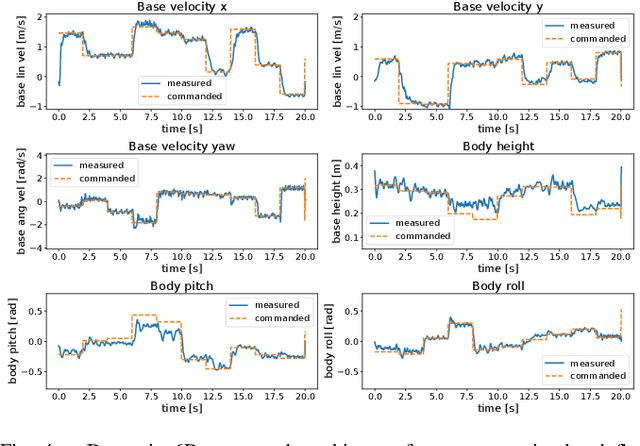
Abstract:With the rapid development of embodied intelligence, locomotion control of quadruped robots on complex terrains has become a research hotspot. Unlike traditional locomotion control approaches focusing solely on velocity tracking, we pursue to balance the agility and robustness of quadruped robots on diverse and complex terrains. To this end, we propose an end-to-end deep reinforcement learning framework for posture-aware locomotion named PALo, which manages to handle simultaneous linear and angular velocity tracking and real-time adjustments of body height, pitch, and roll angles. In PALo, the locomotion control problem is formulated as a partially observable Markov decision process, and an asymmetric actor-critic architecture is adopted to overcome the sim-to-real challenge. Further, by incorporating customized training curricula, PALo achieves agile posture-aware locomotion control in simulated environments and successfully transfers to real-world settings without fine-tuning, allowing real-time control of the quadruped robot's locomotion and body posture across challenging terrains. Through in-depth experimental analysis, we identify the key components of PALo that contribute to its performance, further validating the effectiveness of the proposed method. The results of this study provide new possibilities for the low-level locomotion control of quadruped robots in higher dimensional command spaces and lay the foundation for future research on upper-level modules for embodied intelligence.
Verification of Bit-Flip Attacks against Quantized Neural Networks
Feb 22, 2025Abstract:In the rapidly evolving landscape of neural network security, the resilience of neural networks against bit-flip attacks (i.e., an attacker maliciously flips an extremely small amount of bits within its parameter storage memory system to induce harmful behavior), has emerged as a relevant area of research. Existing studies suggest that quantization may serve as a viable defense against such attacks. Recognizing the documented susceptibility of real-valued neural networks to such attacks and the comparative robustness of quantized neural networks (QNNs), in this work, we introduce BFAVerifier, the first verification framework designed to formally verify the absence of bit-flip attacks or to identify all vulnerable parameters in a sound and rigorous manner. BFAVerifier comprises two integral components: an abstraction-based method and an MILP-based method. Specifically, we first conduct a reachability analysis with respect to symbolic parameters that represent the potential bit-flip attacks, based on a novel abstract domain with a sound guarantee. If the reachability analysis fails to prove the resilience of such attacks, then we encode this verification problem into an equivalent MILP problem which can be solved by off-the-shelf solvers. Therefore, BFAVerifier is sound, complete, and reasonably efficient. We conduct extensive experiments, which demonstrate its effectiveness and efficiency across various network architectures, quantization bit-widths, and adversary capabilities.
Universal Semantic Embeddings of Chemical Elements for Enhanced Materials Inference and Discovery
Feb 19, 2025Abstract:We present a framework for generating universal semantic embeddings of chemical elements to advance materials inference and discovery. This framework leverages ElementBERT, a domain-specific BERT-based natural language processing model trained on 1.29 million abstracts of alloy-related scientific papers, to capture latent knowledge and contextual relationships specific to alloys. These semantic embeddings serve as robust elemental descriptors, consistently outperforming traditional empirical descriptors with significant improvements across multiple downstream tasks. These include predicting mechanical and transformation properties, classifying phase structures, and optimizing materials properties via Bayesian optimization. Applications to titanium alloys, high-entropy alloys, and shape memory alloys demonstrate up to 23% gains in prediction accuracy. Our results show that ElementBERT surpasses general-purpose BERT variants by encoding specialized alloy knowledge. By bridging contextual insights from scientific literature with quantitative inference, our framework accelerates the discovery and optimization of advanced materials, with potential applications extending beyond alloys to other material classes.
 Add to Chrome
Add to Chrome Add to Firefox
Add to Firefox Add to Edge
Add to Edge